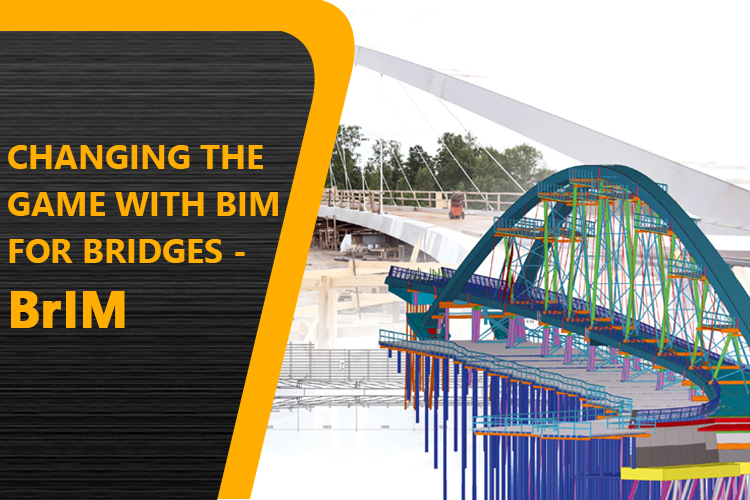Changing the game with BIM for Bridges – BrIM

BIM allows you to foresee issues, access information and act even more confident at each phase of your bridge design project. Minimise re-work and improve predictability for plan and development of bridges and tunnels. BIM provides the means and measures and proves instrumental in guaranteeing that each new task contributes towards these objectives with software that guides advancements in designs, building and development through a collaborative and quantifiable procedure.
While BIM gives a general methodology for coordinating activities through the whole project lifecycle, the absence of an integrated BIM, bridge design and analysis solution has implied that BIM is considered more of a challenge for the engineers to implement while designing bridges. With a planned methodology utilizing best in class innovation, BIM is no longer a barrier in beating the novel issues this complex sector presents.
Helps in Maintaining Safety
The structural integrity of bridges is a crucial and intermittent issue in civil engineering. As of now, many bridges are basically insufficient and needing significant maintenance support, with some moving toward the end of their design life. The related expense to restore these current structures is an extra burden on maintenance budgets.
While each and every bridge is dependent upon environmental factors that influence its condition over time –, for example, traffic volumes, climate conditions, temperature variances and corrosive agents like street salt – a few causes can even be traced back to the nature of the original design plan and development. The explanations behind this are numerous, however ordinarily incorporates inconsistent design data, unreliable data exchange between different parties, poor change control techniques and inadequate design timescales and spending plans.
BIM for bridge design can help solve these issues by providing a single source of information for the project, which can be accessed from anyplace on the planet utilizing cloud-based platforms and open BIM data exchange interfaces. With a BIM arrangement structured explicitly for the bridge industry, dealing with the design procedure and any progressions is altogether more efficient, along with increasing design productivity and quality.
Decreasing time and cost overruns
Bridges are complex structures to both plan and build, especially those with twofold curvatures or variable cross-sections. Streamlining the bridge geometry and the position of inner and outside, longitudinal, transverse and vertical tendons further builds the complexity of the design procedure. To communicate these structures utilizing 2D tools, several drawings must be made manually, taking significant time. Design changes should likewise be made manually in each document at each design stage.
One of the primary advantages of Structural BIM Services is the capacity to have all the project data contained in a central model. While this has commonly been an issue for bridge design, however BIM is presently ready to give a unified geometric, basic analysis and detailed bridge model. By connecting these customarily separate models, the parametric 3D geometry of the bridge can be represented while services as an analytical model for static and dynamic computations along the time axis.
This single-model methodology guarantees expanding ROI for bridge design and development organizations around the world. Any change in any of the bridge lifecycle stage is reflected once to the whole bridge project – a single source of information. Bridge engineers can likewise use the computing power of openBIM to prepare precise quotes dependent on authentic information and data obtained from the model.
BIM Services also known as BrIM can possibly change the bridge maintenance industry by empowering the formation of exact registers of all structures. If the bridge is 50 years of age, at that point the drawings are 50 years of age – and many things could have happened to the bridge during those years. It is important for proprietors to value the advantages of computerized data. The term ‘digital twin’ is progressively being utilized regarding information that reflects any structure, including the capacity to update the consolidate changes through its life beyond the 1st as-built record.
The information should be shared, both with members of bridge design as well as bridge construction and progressively with machines, regardless of whether inside a fabricator’s workshop or for controlling earthmoving equipment on site. That is the reason the standardization is so vital. This is particularly significant since a great deal of construction is pre-assembled, with a transition to congregations that are made off site.
While BIM for bridges can help conquer the difficulties that bridge engineers face, it additionally gives a scope of different advantages during the whole project lifecycle. Dependable and reliable information exchange among al stakeholders, efficient design processes utilizing parametric modeling, better clash detection and joint effort for improved design and development quality and less deferrals all through the project are only a portion of the advantages that can be achieved with BIM solution planned explicitly for bridges.
Conclusion
The advanced digital model must suit all needs of the procedure, from the design stage by means of point by point plan and development to the activity stage all through the lifetime of a bridge. Various partners are associated with these various stages; in this manner, interfaces must be given, and the entire procedure must be moulded to maintain a strategic distance from mistaken assumptions, blunders and entries of repetitive information. Bridge structures are commonly administered by the construction procedure requiring explicit structure analysis and in-time yields to be checked during the procedure. BIM engineers can create a smart, computerized 4D model of the bridge structure, construction process, structural analysis, design and detailing. Consolidating the point by point geometric model and a structural analysis model and coordinating time-related information empowers ventures to be finished faster, with less hazard and more accuracy than at any other time. BIM is not a deterrent to safe and creative bridges on schedule and in budget. BIM is a fundamental tool of transparent, collaborative and cost-effective project delivery.